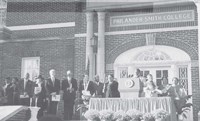- National Mall and Memorial Parks (19)
- Belmont-Paul Women's Equality National Monument (15)
- Boston National Historical Park (10)
- Acadia National Park (9)
- Lewis & Clark National Historic Trail (9)
- Manhattan Project National Historical Park (9)
- Boston African American National Historic Site (8)
- Homestead National Historical Park (8)
- Golden Gate National Recreation Area (7)
- Show More ...
- National Register of Historic Places Program (15)
- Cultural Resources Office of Interpretation and Education (6)
- National Center for Preservation Technology and Training (6)
- San Francisco Bay Area Inventory & Monitoring Network (4)
- Archeology Program (3)
- National Historic Landmarks Program (3)
- Cultural Resources, Partnerships, and Science Directorate (2)
- Geologic Resources Division (2)
- National Heritage Areas Program (2)
- Show More ...
Showing 649 results for teachers ...
School District Number 1
- Type: Place

Nicodemus residents saw education as foundational to their community and organized School District No. 1 in 1879, the first in Graham County. After the previous 1887 schoolhouse burned down in 1916, the District No. 1 Schoolhouse was built in 1918 and used by the district until it closed in the early 1960s.
Roosevelt Lodge
Oak Ridge Wayside: Scarboro
- Type: Person

Mrs. Recy Taylor was just 24 years old when she was brutally raped by six white men in Alabama. Upholding the Black woman's tradition of testimony and protest, Taylor actively participated in the pursuit to bring her attackers to justice. Though the men were acquitted in two separate trials, Taylor's courage speaks to the resolve of Black women to channel their pain and anger into political anger. We honor Taylor as an ancestor for teaching us a lesson on courage.
Oak Ridge Wayside: Integration of Oak Ridge Schools
Old South Meeting House
- Type: Place

In the days leading to the American Revolution, citizens gathered here to challenge British policies, protesting the Boston Massacre and the tea tax. Here, at an overflow meeting on December 16, 1773, the Boston Tea Party began. Saved from destruction in 1876, in the first successful historic preservation effort in New England, the building is now an active meeting place, a haven for free speech, and a museum exhibit, “Voices of Protest.”
Nettie Craig Asberry
- Type: Person

Nettie Craig Asberry is considered the first Black woman to earn a doctorate degree. Her family settled in Nicodemus in 1879, and she taught in town from 1886-1889, teaching both at the District No. 1 School and offering private music lessons. Asberry spent most of her life in Tacoma, Washington where she continued to teach music and advocated for the equal rights of all.
Boston Tea Party at 250
Glen Echo Aquarium
- Type: Person

Marie Equi was born in 1872 in New Bedford. A homesteader in Oregon, Marie became a physician and activist. Equi was placed in charge of obstetrics at the United States Army General Hospital in the Presidio of San Francisco. She was subsequently decorated by the U.S. Army for her humanitarian efforts.
- Type: Article

Latino, African American, Native American and Indigenous peoples, and LGBTQ communities create murals to share their identity and history. While murals all share the large format and public presence, they depict a variety of artistic styles and cultures. When we look at these murals, we can see how communities celebrate their accomplishments, memorialize their pasts and advocate for the future.
Alexander & Catherine Goffar Farm
Free To Learn: African American Schools in Fort Scott
- Type: Article

The passage of the 13th Amendment ended slavery in the United States, but it did not immediately lead to opportunity and equality. Education was key to helping students succeed. From the end of the Civil War until the 1950s when schools were integrated, four Fort Scott African American schools did their best to provide opportunities for their students.
Philander Smith College and the 1957 Crisis
- Type: Place

In 1957, Little Rock’s Philander Smith College, an historically black college, opened its doors to the “Little Rock Nine” to help them prepare for their first days as students at Central High School. Barred from entering the all-white high school by order of the governor, the students struggled to keep from falling behind in their coursework, aided by Philander Smith College faculty members.
- Type: Article

What actions should you take when believe something needs to change? In this learning activity designed for sixth-eighth grades, students examine a flier created by the National American Woman Suffrage Association that lists six reasons that women should be enfranchised across the country by amending the U.S. Constitution. They will analyze the arguments presented by the suffragists. Extend the lesson by creating your own flier.
- Type: Article

How can popular culture be used to advocate for change? In this learning activity for sixth-eighth grade, students examine a suffrage illustration modeled on a popular cartoon circulated during Teddy Roosevelt's re-election campaign. They will analyze the use of cultural touchstones to change public perception about an issue and evaluate when they have been influenced by popular culture.










